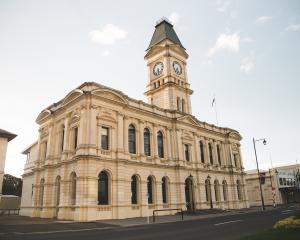
Next month as New Zealand fashion is celebrated at Dunedin’s iD fashion week one of the country’s most unlikely collectors of high-end New Zealand fashion will be celebrated, Naseby farmer Eden Hore.
Josie Steenhart talks to Dr Jane Malthus, one of the team behind the tribute.

What you might be more surprised to find also greeting you, however, would be a rare white peacock, ostriches, emus, Tibetan yaks, dingoes, lovebirds, a cockatoo, an elderly coyote, an assortment of miniature horses decked out in decorative harnesses and nine acres of ornamental gardens and lawns featuring a 21-jet illuminated fountain.
Poking your head into the 130sq m shed originally built to store tractors and grain, your belief would be further suspended when presented with more than 120 couture gowns and garments, created by many of New Zealand’s most celebrated designers of the times, displayed in glass-fronted wardrobes, a replica of Princess Anne’s 1973 wedding dress made using 25 metres of silk, at least 30 taxidermied animals, large dolls dressed in national costumes, miniature trains, trucks and cars, 280 Jim Beam decanters and 70-plus porcelain Jim Beam jugs.

"When you entered [the shed], you saw a tableau of taxidermied animals to the right — a yak, coyote, lambs, rabbits, deer, for example — and on the left were noticeboards with images of the clothes being worn in the 1970s and articles about shows Eden had done back then.
"Into the showroom, you were confronted with colour, lots of glamorous gowns with sequins, feathers, frills hanging in display cases, Eden’s other collections — Jim Beam whiskey decanters, Franklin Mint dolls, travel and Miss New Zealand memorabilia interspersed, on top of cases or in their own waist-high cases, and underneath it all a very ’70s orange-coloured sculptured wool carpet!
"Tourists from New Zealand and overseas came for a day out, probably thinking it was all a bit bizarre, but for anyone I’ve met who visited back then, it was certainly memorable. They could describe it all in some detail," Malthus says of visitors to the farm.
And at the heart of it all was Eden Hore himself (1919-97), whom Malthus describes in Central Otago Couture: The Eden Hore Collection (published March 2025 by Te Papa Press) as "a successful high-country farmer from the Māniatoto, who surprised not only his neighbours but the nation in the 1970s when he embarked on an unexpected foray into collecting what he called ‘high and exotic fashion’."
"When we [returned] there in 1988 selecting and photographing the garments for an exhibition (held at Otago Museum in 1989, called "One Man’s Fantasy") he sat, dressed in his white overalls, in one of his peacock chairs for most of the day, watching and remembering things about the clothes.
"I wish I had paid more attention or taped it all — I didn’t realise then that this collection would become my life’s work!"
As well as displaying his prized garments in the "Tractor Shed", as his showroom became known, the cattle farmer and former World War 2 soldier also held fashion shows both locally and around New Zealand.
One of the first times he took his collection on the road was to raise money for upgrades to Dunedin’s Regent Theatre. The 1974 "fashion spectacular", held at the theatre, featured 98 pieces from bikinis to ballgowns, modelled by Joanne School of Charm models to an audience of 300.
That was followed by fashion parades in Queenstown, Alexandra, Balclutha, Invercargill, Gore and Dunedin as well as in the "Tractor Shed", many of which raised money for charity. In 1976, Hore reportedly hosted an event on the property with more than 4000 guests.
"Eden was mostly a quietly spoken man, except when moving stock, driven by a desire to do something for his community, but that something was unexpected in a rural environment," Malthus says.
Hore described himself as an introvert, she says, but also loved providing entertainment for people — in the form of his collections, aviary, petting zoo, back-country trips, garden parties and fundraising fashion shows.
"As his stock agent, Ren Lothian, reminisced: ‘This frock thing ... wasn’t the normal for a cocky in those days, not in the Māniototo’," Malthus says in Central Otago Couture.
"Eden Hore was a man of many contrasts. He embodied and boldly defied the stereotype of the ‘southern man’, confidently forging his own idiosyncratic path through life. He was a community-minded loner, a quietly spoken showman, a seasoned traveller with a deep love of home and an astute stockman with a sharp eye for a quality fabric and hand-embellished detail. His retirement plan involved establishing a multi-faceted attraction on his property, reflecting his many interests, to draw visitors to the region that he loved."

"He could seem mercurial, enigmatic and unpredictable, yet had often thought deeply about things before acting, surprising others only because he hadn’t voiced those thoughts. His life seemed to take unexpected turns, but to Eden these changes in direction always had a purpose. He described himself as shy and introverted, yet delighted in creating opportunities for friends and family to get together.
"His own dress sense reflected these differences and purposes. On the farm he dressed as most farmers did, in homespun wool jerseys or jackets for warmth and moleskins or wool trousers with boots, but later in life, when he was concentrating on his pet animal collection and his showroom, he wore white overalls and a cap so he could appear ‘reasonably respectable even if I am dirty’.
"As a showman up on the stage with his models he would wear a dark grey or white dinner jacket and black trousers, or a batik fabric sports coat he bought in Asia. He sported a range of colourful shirts, some floral or even leopard print, when out on the town or for evenings at the Danseys Pass Hotel, his local pub, eatery and sometime second home. At home in the winter he often wore an iconic 1970s Cowichan wrap cardigan."
Hore’s collection was bought by the Central Otago District Council (CODC) in 2013. Now branded simply as Eden Hore Central Otago (EHCO), it comprises 226 garments by 41 designers or manufacturers and 49 accessories, including hats, shoes and costume jewellery.
"These clothes are from New Zealand designers who were well known in the 1960s, ’70s and ’80s, but our fashion design history has largely forgotten them, for example, Kevin Berkahn, Colin Cole, Vinka Lucas, Pauline Kingston, Beverley Horne, Pat Hewitt, Jo Dunlap, Maritza Tschepp, Eleanor Joel, Miranda Joel," Malthus says.
"So I think it is hugely significant to have such great examples of their work together in this collection. To be able to tell stories of our design past, the competitions, the work with wool and skins, with such wonderful examples to show people, is inspiring to upcoming designers and entrepreneurs, I hope."
Of particular note, she says, are garments that won prizes such as the Wool Awards, Australian Gown of the Year and Benson and Hedges Fashion Design Awards — "those that tell the stories of our material and textile history: licences for importing, tariffs to protect our wool industry, companies that set up factories in New Zealand to get around these rules imposed by governments", and those illustrate our design, culture and social history.

"These decades saw social and cultural shifts in fashion as the baby-boom generation resisted the dictates of mainstream fashion, and influences came from sources outside the traditional fashion world.
"There are so many stories that can be told through this collection."
This year, as well as the release of Central Otago Couture, co-authored by Malthus with Te Papa senior curator and award-winning author Claire Regnault, highlights from Hore’s collection will be on display at Dunedin’s Toitū Otago Settlers Museum from April 2 until April 21, 2027.
Displayed in both are contemporary images shot in the unique landscapes and locales of the South by celebrated Kiwi photographer Derek Henderson.
"Seeing and experiencing the garments being worn and moving in the wonderful Central Otago landscapes was magical," Malthus says.
"The way the clothes came to life when being worn ... was enlightening."
She says looking after the garments — and the models — while out in the environment was a challenge.
"While the collection isn’t in a museum, we all want to preserve it for posterity, so we were very careful about handling, where and how models change into and out of them, keeping them away from sources of soiling, etc.
"In the images you can’t see the protective ground coverings, the hot water bottles, rugs and dressing to keep the models warm (because we were often out at dawn and dusk to get the best light), the vans kitted out with garment racks and bags, dust covers, or some of the roads we travelled on to get to our locations."
TO SEE:
"Eden In Dunedin", Toitū Early Settlers Museum, April 2, 2025-April 21, 2027; Author talk: Derek Henderson, Jane Malthus and Claire Regnault; chaired by Michael Upchurch, Toitū auditorium, April 2, noon.












